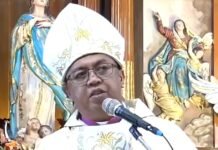The former 17th UP Systems president bared that UP gets 25 percent of the nation’s budget for higher education but produced only two percent of its graduates.
Brimming with conviction and sincerity, Dr. Javier, a columnist in the Manila Bulletin, thundered: “Where is the equity in this? he bewailed. “What UP can offer, it should be able to offer with other colleges and universities.”
In response to the National Scientist’s comments. Dr. Azanza, the CatSU working president, said he has already talked with the UPLB Chancellor regarding the offering of joint courses, with a team of faculty members set to explore the possibility of inking a memorandum of agreement (MOA). President Azanza disclosed that a proposal for CatSU to establish an Open University is now up to for approval of the Board of Regents (BOR).
On the Agro-Industrial Economic Processing Zone (AIEPZ), Dr. Azanza added that he has already started talks with potential private partners. As to criticisms by some quarters of his paying calls on politicians, he said that he is seeking support for the funding of CatSU’s proposed P1 billion funding for the eco-zone.
The CatSU top honcho who wears two hats–as educational leader and CEO of its corporate entity clarified that he wasn’t doing this for popularity but to pull strings for the university just like what his mentor–Dr. Emil Q. Javier — did through side talks and backdoor negotiations during his time as UP president. This includes the P50 million allotment for a 3-storey Smart Student Center (SSC) and separate funding for an on-campus housing for the faculty.
Dr. Azanza further bared that a proposed foundation is aimed at setting up fund for the faculty, including the establishment of professorial chairs that would come with a grant of P59,000 or more.
***
Sometime in August 2001, the National Academy of Science and Technology (NAST) published its maiden issue of a monograph series, NAST Monograph Series No. 1/2001. Published in this maiden monograph series were selected papers presented during fora organized by NAST. These papers present issues affecting the live of the Filipino people, the preface of the monograph added.
” Recognizing the important role of modern biotechnology as a tool to improve agricultural productivity to feed and improve the lives of the growing population and to address environmental degradation, the NAST has sponsored or co-sponsored fora and meetings to discuss issues and concerns of modern biotechnology with various sectors and stakeholders.
The National Science and Technology (Philippines) is the highest advisory and recognition body of the government on science and technology, accordingly to Perla D. Santos Ocampo, M.D., then president of NAST.
The paper presented by Academician Dr. Emil Q. Javier was titled ” Sustainably Productive Agriculture and Genetically Modified Crops ‘. For starter, he used FAO’s definition of ” sustainable agriculture and rural development ‘ as the management and conservation of the natural resources base, and the orientation of technological and institutional change in such a manner as to ensure the attainment and continued satisfaction of human needs for present and future generations.”
Aside from being appointed 17th UP Systems president, Dr. Javier is former professor of Agronomy, UPLB, Chair, Technical Advisory Committee, Consultative Group on International Agricultural Research (CGIAR).
“The need for sustainably productive agriculture looms larger and larger in the horizon as we begin the 21st century. Between the year 2000 and 2025 the world population will increase by almost two billion people. To feed this additional population it has been calculated that the average yields of cereals must be 80 percent higher than the average yields in 1990”, he said. And to think that that estimate was made 32’years ago.
In the Philippines, our population has been projected to increase from 77 million in 2000 to 108 million in 2020, unfortunately the year when the COVID 19 pandemic devastated us economically, emotionally, financially.
For rice alone our requirement will escalate from 12.8 million tons to 17.9 million tons, an increase of 40 percent (Hossain and Sombilla, 1999). However, because land and water are becoming increasingly scarce, these increases must come primarily from increasing biological yields, not from area expansion and more irrigation (Serageldin, 1999).
The Convention on Biological Diversity (CVD) defines biotechnology as any technological application that uses biological systems, living organisms, or derivatives thereof, to make or modify products or processes for specific uses. It is the new label for a process that human have used for thousands of years to ferment foods such as beer, wine, bread and cheese (Vogt and Parish, 1999).
According to Dr Javier, modern biotechnology could be a powerful tool for improving productivity and sustainability of agriculture in developing countries. However, as with all other innovations and changes involving complex systems, there will always be trade-offs; there will always be unintended unwanted consequences that accompany the gains. It is a matter of weighing the risks against the benefits, of avoiding or mitigating the unwanted consequences and intelligently deciding which aspects of charge to accept and which to reject, he cautioned.
A major application of modern biotechnology is the development and use of genetically modified or transgenic crops. Crops may be genetically modified to raise yield ceilings, improve resistance to pests and diseases, develop tolerance to drought, excessive temperatures, soil acidity and other abiotic stresses, and improve the nutritional, processing and keeping quality of produce.
The applications of modern biotechnology in health, industry and on the environment are widely accepted. However, there are objections and unease in their uses in food and agriculture, particularly in the use of genetically modified crops.
Committee hearing on Tourism 8/26/22 PBM Edwin Tanael presides, PBM Sonny Francisco is present.
Consider the suggestion provided by rep from San Andres well taken by PBM Tanael.
Catanduanes festival. Padadyaw festival. One time bigtime activity. Rigodon to be part of foundation anniversary. One or two days.
Gov. Alcantara started the activity initially for Baras. But later naging comprehensive.
Group to submit proposal. Pa bonggahon ang abaca festival. If there are group to bid are invited to host the Catandungan Festival.
One rep for the beauty pageant. Municipal tourism officer per municipality. May municipality ayaw sumali.
Mutya Ng Pandan for example should represent. Recommended by Tourism officer to the Mayor. Secretariat should provide the guidelines. Stay on the agreement of only one representative per municipal as recommended by Tourism officer and Mayor.
Dole job fair for abaca festival no longer sa Catandungan Festival. PBM said we’re trying to refocus our actions. Little by little (gradually). Catandungan Festival 2022 .
Finalize the program and will meet again. The meeting is adjourned at 11:32 a.m.
( via Ex-prof Buddy Isorena)























